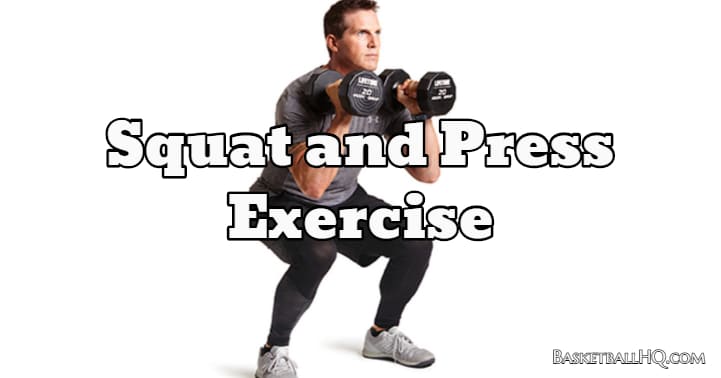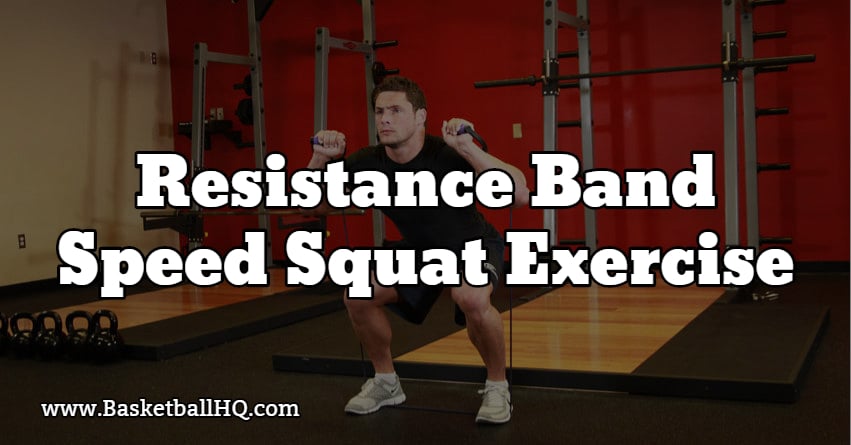
Basketball exercises for developing strength, explosiveness, quickness, etc., are becoming more and more a part of the game today. If a player cannot physically keep up with the competition, they usually tend to struggle on the court. However, most younger basketball players and coaches don’t really know much about training specifically for basketball in the weight room, so they shy away from it. This basketball workouts section exists to fix that problem.
These basketball exercise training videos will be instructed by a professional strength and conditioning coach who has worked with high-level college and professional basketball players. Every exercise will be broken down in the video so that you can see exactly how it is done. Along with seeing how it is done, the trainer will explain what it is working on related to basketball.
After checking out, these different basketball exercises, make sure that you check out our list of the best basketball training equipment to find the right tools you will need in the weight room.
The Importance of Basketball Exercises
If you are coaching basketball in high school or at a smaller college, there is a pretty good chance that you don’t have a big enough budget to hire a full-time strength and conditioning coach for your team. That means that the responsibility is most likely going to fall on you. That is where we come into play.
These basketball exercises are designed to help you learn how to do the specific exercise and then teach it to your players. This way, you will be able to have full confidence with your basketball team in the weight room and see some really positive strength growth with your team, and by adding this to your on-court basketball training, you will see maximum growth in your players.
Basketball Exercises Teaching Points
Basketball is a fast-paced and physically demanding sport that requires players to have a strong foundation of fundamental skills. As a coach, it is important to design effective exercises that focus on improving these skills while also keeping your players engaged and motivated. In this section, we will discuss some key teaching points for coaches when it comes to designing basketball exercises.
1. Emphasize Proper Technique
When designing basketball exercises, coaches should always emphasize and prioritize proper technique over speed or intensity. This is especially important for younger players who are still developing their skills. By reinforcing the correct form and mechanics from the beginning, coaches can help prevent bad habits and injuries in the long run.
For example, when teaching shooting drills, focus on proper footwork, hand placement, and follow-through instead of just speed or number of shots made. By emphasizing technique, players will ultimately become more efficient and accurate shooters.
2. Incorporate Game-like Scenarios
Basketball is a dynamic sport that requires players to make quick decisions under pressure. To prepare your players for game situations, it is important to incorporate game-like scenarios into your exercises. This can include adding defenders, setting up specific plays or situations, and incorporating game rules such as shot clocks.
By simulating game scenarios in practice, players will develop the necessary skills and decision-making abilities to perform well during actual games.
3. Progressively Increase Difficulty
It is important for coaches to challenge their players and push them outside of their comfort zones in order for them to improve. However, this should be done progressively and gradually. Starting with simpler exercises and then increasing difficulty level over time allows players to build upon their skills and see tangible improvements.
For example, when teaching ball handling drills, start with basic stationary dribbling exercises and then gradually add in movement, defenders, and more complex dribbling patterns.
4. Provide Feedback and Encouragement
As coaches, it is important to provide constructive feedback and encouragement to your players during exercises. This not only helps them improve their skills but also boosts their confidence and motivation.
When giving feedback, be specific and focus on areas for improvement rather than criticizing mistakes. Additionally, make sure to praise good form and execution to reinforce positive behaviors.
5. Keep it Fun and Engaging
Lastly, it is important to keep your players engaged and motivated during exercises by making them fun and interactive. Incorporate competitive elements, teamwork drills, or even friendly challenges to make the learning process more enjoyable for your players.
Additionally, be mindful of varying skill levels within your team and modify exercises accordingly so that everyone can participate and feel challenged.
By following these key teaching points, coaches can design effective basketball exercises that not only improve fundamental skills but also keep players motivated and engaged. Remember to always prioritize proper technique, incorporate game-like scenarios, gradually increase difficulty, provide feedback and encouragement, and keep it fun for your players!
Must-Use Basketball Exercises
Being strong on the court not only leads to your players performing better, but it can also help with injury prevention. With our basketball exercises, you can allow your players to play at their top physical performance, as well as help them keep their bodies feeling healthy.
Exercise #1: Squat and Press Exercise

The squat and press exercise is a compound movement that will work on both the lower and upper body. It is also an exercise that is going to work on a specific basketball movement. It will work on generating power off of two legs for finishing around the basket, rebounding, etc. The shoulder press at the end of the movement is also going to work on being able to finish through contact. So if the defender goes to foul the player on the finish, they will be able to power through and get the and one.
Basketball exercises like this are a must if you want to maximize your athleticism as a player. Make sure, though, that you spend the time learning the correct form before you add this exercise to your basketball training plan. This will help to prevent injuries from happening and also to promote maximum muscle and strength growth.
Basketball Exercise Overview
Exercise Name: Squat and Press Exercise
Equipment Needed: Dumbbells or barbell.
Goals of the Exercise
- Develop strength and explosiveness in the legs, shoulders, and upper back.
Coaching Points
- Really focus on having the correct form, even if it means starting with a lighter weight at the beginning.
- Be explosive with your upward movement, and use the momentum from standing up to help you push press the weight upwards.
- Don’t let your form suffer as you get tired.
Basketball Exercise Instructions
- Grab a pair of dumbbells or a barbell and hold the weight at shoulder level.
- With your feet about shoulder-width apart, you are going to squat down to a 90-degree angle.
- Explosively stand back up, and as you are about all the way up, you will push press the weight up over your head.
- Lower the weight back down to your shoulders to finish the repetition.
Exercise #2: Reverse Body Weight Row Exercise

The reverse bodyweight row exercise is going to focus on the upper back, shoulders, and arms. It is a great basketball exercise for all players, but it is an excellent exercise for younger players trying to stay away from lifting heavier weights.
Like most exercises that you do, the better your form is, the more you will get out of it. The great thing about the reverse row is that you can add or decrease the difficulty of the exercise based on the player, which should help them keep the correct form while doing the exercise. Some of the ways that this exercise will translate onto the court are in rebounding the basketball or finishing around the rim when there is contact. It is important to make sure that you compliment your basketball training with weight room time to promote maximum player development.
Basketball Exercise Overview
Exercise Name: Reverse Body Weight Row Exercise
Equipment Needed: Squat rack bar, bench, and weighted plates (for advanced versions of exercise).
Goals of the Exercise
- Build strength in the upper back, shoulders, and arms.
Coaching Points
- Control your speed going up and down. Keep your core tight and your back straight the entire time.
Basketball Exercise Instructions
- Place a bar in the squat rack about 3-4 feet off the ground (level will depend on player’s arm length).
- Lay down under the bar and grab the bar so that your hands are about shoulder-width apart, and the bar is even with your chest.
- Make your body out into a straight line so that only your heels touch the ground and you are hanging by your arms.
- Now pull your upper body up to the bar and touch your chest to the bar.
- Freeze slightly at the top, and then lower yourself back down.
- This completes one repetition.
Beginner Version: To make the exercise easier, bend at the knees, and place your feet flat on the ground. Knees should make a 90-degree angle.
Advanced Version: Place a flat bench out in front of the bar and rest your feet on the bench instead of on the ground. You can also place a weighted plate on your chest or use resistance bands.
Exercise #3: Resistance Band Speed Squat Exercise

The resistance band speed squat exercise will be great for developing explosiveness and quickness in a player’s legs. Using a resistance band instead of weights works well because it allows the player range of motion when doing the exercise. Using a barbell to do squats is still a great exercise, but this specific exercise will help focus on a couple of different areas, and it really lets the player be explosive in their movements.
Being able to jump quickly translates into so many different areas of the game of basketball. Whether it is; jumping to block a shot, grabbing a rebound, or finishing at the rim, the player who can get off the ground the quickest has a big advantage. This exercise is going to help develop a player’s fast-twitch muscles and make them more explosive. This basketball exercise will help to teach good jumping technique and learning to be explosive. So you must make sure this translates over to the court and that you continue to work on being explosive in your basketball training as well.
Basketball Exercise Overview
Exercise Name: Resistance Band Speed Squat Exercise
Equipment Needed: Squat rack, weighted ball, and a resistance band.
Goals of the Exercise
- Work on becoming an explosive and quick jumper.
Coaching Points
- Focus on good form and squatting technique.
- Push yourself to be as explosive as you can, and if you feel that the resistance is too much, find a weaker band.
- Don’t let your knees angle in when you squat down.
- There are two different variations to this basketball workout.
- Variation 1: Squat down at a slower speed and then explode upwards. Works on explosiveness and technique.
- Variation 2: Complete the squats as quickly as you can, going up and down at the same speed. Works on muscle endurance.
Basketball Exercise Instructions
- Set up two safety bars on the front of the squat rack at about waist height, and then place a resistance band around the bars.
- Place a weighted ball under the resistance band.
- Sit down on the weighted ball and put the resistance band over top of your upper back area.
- Bring your arms over top of the resistance band to help hold it in place and then stand up.
- Now squat down until your butt touches the weighted ball, and then stand back up as quickly as possible.
- This completes one repetition.
Why Basketball Exercises
Basketball exercises are crucial for the overall development of a basketball team. They not only improve individual skills but also help players develop chemistry and communication with their teammates. Additionally, practicing specific drills and scenarios helps teams develop strategies and prepare for game situations.
Moreover, incorporating exercises in practice also promotes an active and healthy lifestyle for players. Regular physical activity is important for maintaining good health and can also help prevent injuries during games.
Furthermore, basketball exercises provide a platform for coaches to teach important life skills such as discipline, teamwork, and perseverance. These qualities are not only beneficial on the court but also in all aspects of life.
Lastly, basketball exercises allow players to constantly improve and push themselves to be the best they can be. As they see progress and growth in their skills, players become more motivated and confident, leading to an overall improvement in team performance.
Basketball Exercises Tips and Tricks
- Always start with a warm-up to prevent injuries and prepare the body for physical activity.
- Vary exercises to keep players engaged and challenged.
- Incorporate conditioning drills to improve overall fitness.
- Use different equipment such as cones, agility ladders, or resistance bands to add variety to exercises.
- Include individual skill work as well as team-oriented drills to promote overall development.
- Encourage players to practice on their own outside of team practices.
- Set goals for players and track progress to keep them motivated.
- Have fun and create a positive learning environment for your players.
- Don’t be afraid to modify exercises for different skill levels and abilities within the team.
- Incorporate mental training techniques such as visualization and positive self-talk during exercises.
- Always end with a cool-down to help prevent injuries and promote recovery.
By utilizing these tips and tricks, coaches can create effective and engaging basketball exercises for their teams. Remember to prioritize proper technique, incorporate game-like scenarios, increase difficulty gradually, provide feedback and encouragement, keep it fun, and highlight the benefits of these exercises to motivate your players. With consistent practice and dedication, players will see improvement in their skills and overall team performance on the court.
Basketball Exercises Frequently Asked Questions
How should you workout as a basketball player?
As a basketball player, your training should emphasize building leg power, core strength, and quick, explosive actions. Include a variety of exercises such as squats, lunges for lower body strength, and plyometric drills to boost your explosiveness. Agility drills will help with quick directional changes on the court. Don’t forget about cardio workouts; incorporating sprints and high-intensity interval training (HIIT) will greatly enhance your stamina, ensuring you can maintain a high level of play throughout the game.
How do I get my body in shape for basketball?
To optimize your physical condition for basketball, incorporate 5 rounds of squat jumps into your training regimen, aiming for each round to last between 20 to 30 seconds. Adding weights to your squat jumps can significantly enhance your vertical leap. This exercise is beneficial not only for increasing your jumping ability but also for enhancing key basketball skills such as grabbing rebounds, executing dunks, and blocking shots efficiently.
How do you train strength for basketball?
Strength training for basketball should focus on exercises that improve explosiveness, power, and agility. Some key exercises to incorporate include squats, lunges, plyometrics, and resistance band exercises. It is important to gradually increase weight and difficulty over time to continue challenging the muscles and improving strength. Additionally, incorporating a proper warm-up and cool-down routine can help prevent injuries during strength training exercises.
How often should basketball players do strength training?
It is recommended for basketball players to do strength training at least 2-3 times a week. However, the frequency and intensity of their sessions can also depend on factors such as age, skill level, and overall physical condition. It is important for players to have adequate rest and recovery between strength training sessions to prevent injuries.
What are some good stretches for basketball players?
- Standing Toe Touches
- Hamstring Stretches
- Quad Stretches
- Calf Raises
- Hip Flexor Stretches
- Shoulder Rotations
- Arm Circles
- Wrist and Hand Stretches
- Figure Four Stretch (for hips and glutes)
- Chest and Upper Back Stretches.
It is important for basketball players to properly stretch before and after practices or games to prevent injuries and improve flexibility.
Can basketball exercises be modified for younger players?
Yes, basketball exercises can definitely be modified for younger players. It is important to consider the age, skill level, and physical capabilities of your players when designing exercises. For younger players, it may be beneficial to focus on basic skills such as dribbling, passing, and shooting before moving on to more advanced drills. Additionally, using smaller equipment or modifying the rules of a game can make exercises more accessible for younger players.
How can basketball exercises improve my shooting skills?
Basketball exercises can improve shooting skills by incorporating shooting drills that focus on proper technique, footwork, and shooting under pressure. Additionally, practicing shooting from various spots on the court and using game-like scenarios in exercises can also help improve shooting accuracy and consistency. Remember to also provide feedback and encourage players to constantly practice their shooting skills outside of team practices.
More Basketball Exercises
- Squats
- Deadlifts
- Bench Press
- Dumbbell Rows
- Shoulder Presses
- Lunges
- Bicep Curls
- Tricep Extensions
- Pull-Ups
- Planks and Core Workouts
Basketball Exercises Conclusion
By incorporating a variety of exercises, setting goals, and providing guidance and motivation, coaches can design effective basketball workouts that will help players improve their skills and overall fitness. Remember to prioritize proper technique, gradually increase difficulty, incorporate mental training techniques, keep it fun and engaging, and always end with a cool-down. With consistent practice and dedication, players will see improvement in their game and overall team performance.


